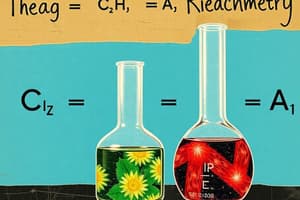Podcast
Questions and Answers
According to the law of conservation of mass, which of the following must be equal on both sides of a chemical equation?
According to the law of conservation of mass, which of the following must be equal on both sides of a chemical equation?
- The number of atoms of each element (correct)
- The total volume of reactants and products
- The electric charge
- The number of molecules
Coefficients are used to show the types of atoms present in a chemical equation, while subscripts are used to balance the equation.
Coefficients are used to show the types of atoms present in a chemical equation, while subscripts are used to balance the equation.
False (B)
In the unbalanced equation $H_2 + O_2 \rightarrow H_2O$, which substances are considered the reactants?
In the unbalanced equation $H_2 + O_2 \rightarrow H_2O$, which substances are considered the reactants?
$H_2$ and $O_2$
Balancing chemical equations ensures that the number of atoms of each __________ is the same on both sides of the equation.
Balancing chemical equations ensures that the number of atoms of each __________ is the same on both sides of the equation.
Which of the following must be conserved when balancing chemical equations?
Which of the following must be conserved when balancing chemical equations?
A balanced chemical equation has the same number of molecules on both sides of the equation.
A balanced chemical equation has the same number of molecules on both sides of the equation.
What is the role of coefficients in a chemical equation?
What is the role of coefficients in a chemical equation?
In a chemical equation, the substances on the left side of the arrow are called __________, while the substances on the right side are called ___________.
In a chemical equation, the substances on the left side of the arrow are called __________, while the substances on the right side are called ___________.
What is the first step in balancing a chemical equation?
What is the first step in balancing a chemical equation?
The equation $2H_2 + O_2 \rightarrow 2H_2O$ is an unbalanced equation.
The equation $2H_2 + O_2 \rightarrow 2H_2O$ is an unbalanced equation.
In the balanced equation $2H_2 + O_2 \rightarrow 2H_2O$, how many molecules of hydrogen ($H_2$) are present?
In the balanced equation $2H_2 + O_2 \rightarrow 2H_2O$, how many molecules of hydrogen ($H_2$) are present?
When balancing chemical equations, you can only change the __________, not the __________.
When balancing chemical equations, you can only change the __________, not the __________.
Which of the following equations is balanced?
Which of the following equations is balanced?
The final step in balancing a chemical equation is to adjust the coefficients to ensure the number of molecules is the same on both sides.
The final step in balancing a chemical equation is to adjust the coefficients to ensure the number of molecules is the same on both sides.
What does the arrow ($\rightarrow$) signify in a chemical equation?
What does the arrow ($\rightarrow$) signify in a chemical equation?
The Law of _______ ______ states that mass is neither created nor destroyed in a chemical reaction.
The Law of _______ ______ states that mass is neither created nor destroyed in a chemical reaction.
Consider the unbalanced equation $CH_4 + O_2 \rightarrow CO_2 + H_2O$: After balancing, what is the coefficient in front of $O_2$?
Consider the unbalanced equation $CH_4 + O_2 \rightarrow CO_2 + H_2O$: After balancing, what is the coefficient in front of $O_2$?
If an equation is balanced, it violates the Law of Conservation of Mass.
If an equation is balanced, it violates the Law of Conservation of Mass.
Balance the following equation: $Na + Cl_2 \rightarrow NaCl$.
Balance the following equation: $Na + Cl_2 \rightarrow NaCl$.
If one were to balance the chemical equation $C_4H_{10}+ O_2 \rightarrow CO_2 + H_2O$, the coefficient in front of $O_2$ in the balanced equation would be _______.
If one were to balance the chemical equation $C_4H_{10}+ O_2 \rightarrow CO_2 + H_2O$, the coefficient in front of $O_2$ in the balanced equation would be _______.
Flashcards
Law of Conservation of Mass
Law of Conservation of Mass
The principle stating that matter cannot be created or destroyed in a chemical reaction.
Reactants
Reactants
Substances initially involved in a chemical reaction that react to create products.
Products
Products
Substances that are formed as the result of a chemical reaction.
Coefficients
Coefficients
Signup and view all the flashcards
Unbalanced Equation
Unbalanced Equation
Signup and view all the flashcards
Balanced Equation
Balanced Equation
Signup and view all the flashcards
Steps to Balance a Chemical Equation
Steps to Balance a Chemical Equation
Signup and view all the flashcards
Study Notes
- Chemical reactions follow the Law of Conservation of Mass
- The number of atoms of each element must be the same on both sides of the equation
Understanding Chemical Equations
- An example of a chemical equation is H2 + O2 → H2O, where H2 and O2, are reactants and H2O is the product
- Coefficients are used to balance the equation
Steps to Balance Chemical Equations
- Write the unbalanced equation, for example H2 + O2 → H2O
- Count the atoms of each element on both sides of the equation
- In the example H2 + O2 → H2O, there are 2 hydrogen atoms and 2 oxygen atoms on the reactant side, and 2 hydrogen atoms and 1 oxygen atom on the product side
- Use coefficients to balance the atoms
- For example, 2H2 + O2 → 2H2O
- Check the work to ensure the equation is balanced
- In the example, 2H2 + O2 → 2H2O there are 4 hydrogen atoms and 2 oxygen atoms on both sides
Studying That Suits You
Use AI to generate personalized quizzes and flashcards to suit your learning preferences.




